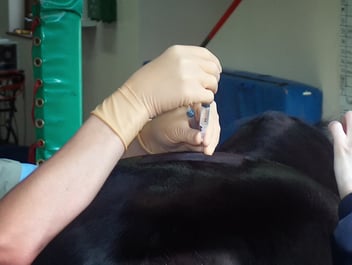Technique Tuesday - Atlanto-Occipital CSF
This Technique Tuesday, our co-founder and equine veterinary surgeon, Jennifer Corley, is sharing her expertise on the atlanto-occipital cerebrospinal fluid collection technique. Have questions or comments? Drop them in the comment form below, and Jennifer will be more than happy to help! Stay tuned for more exciting insights and techniques from our amazing team!

Equipment Required:
• Facility for general anaesthesia
• Clippers with a fine blade
• Chlorhexidine scrub solution and alcohol swabs
• 18G spinal needle 3.5 inches (9cm) long
• Surgical gloves
• Sample pot
Procedure:
The horse is positioned in lateral recumbency with the head in a flexed position. The poll is clipped and aseptically prepared.
Anatomy for site for collection:
Midline at a point intersected by a line drawn between the cranial border of the atlas. The needle is directed toward the lower jaw and advanced until the dura is penetrated. Usually a depth of 5-6cm in an adult horse. It is important to stay in a median plane as it is possible to miss the space by angling laterally. Resistance will be felt as the nuchal ligament is penetrated followed by a characteristic “pop”. The stylet can then be withdrawn and the fluid collected. If no fluid comes out then the needle should be advanced in 1mm steps.
Aftercare:
1-2 days of stall rest feed from a hay net for 1-2 days, NSAIDs as required.
Normal values for CSF from the atlanto-occipital spaceTotal protein (g/L) 1-12Total protein (mg/dl) 10-120Nucleated cell count (/l) 0-7Red blood cell count (/ul) 0-600Glucose (mmol/L) 1.7-3.9 Glucose (mg/dL) 30-70Creatine Kinase (IU) 0-8
References:
1. Martin Furr Atlanto-occipital cerebrospinal fluid collection. The Equine Hospital Manual. Page 80/81 Blackwell Publishing 2008.
2. Mayhew I Collection of CSF from the horse. Cornell Vet 65:500-502, 1975.




